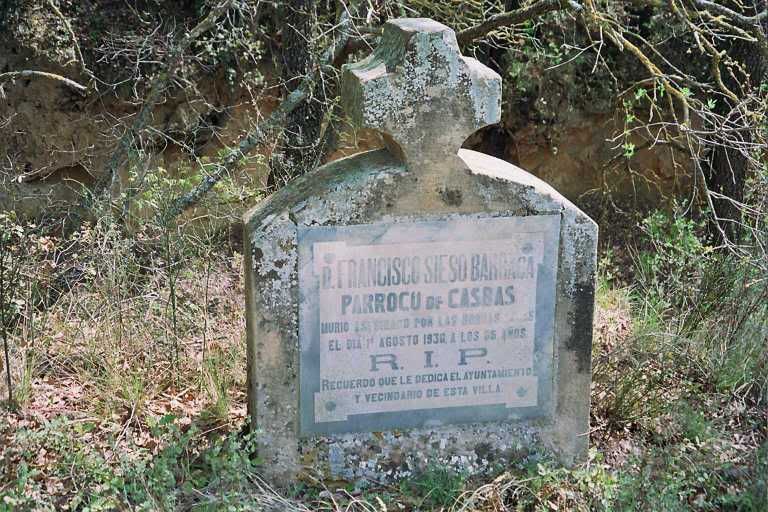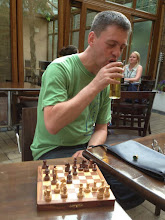Bad Santa
Say what you like about the Catholic Church, they know how to put on a show. All last week, down the Coso, in Huesca as in every other town in Spain, parading with drums and banners, dressed in cultish robes and hooded like the Ku Klux Klan. Semana Santa, Holy Week: the commemoration of the Crucifixion and the reminder of the Catholic Church's obsession with violent death. Be thankful for small mercies, that we do not get auto-crucifixion like they put on in the Philippines: here in Spain the preference has always been for torturing other people, and they are not allowed to do that any more. They do, however, have people who bang their drums without gloves so that their hands are torn, as if mangled with stigmata, and drip blood onto the drum as a symbol of their penitence. Be thankful for small mercies, because when you understand the Catholic Church, you understand that they are serious about pain and about suffering. Be thankful for small mercies, and for larger ones, that the Catholic Church in Spain no longer has the power to put into practice what it symbolises in show.

But it knows how to put one on. In a sense the Catholic Church is show, the overcoming of resistance by appeal to the power of the senses (and, if that fails, by fire and sword). The incense, the finery, the magic spells. There is not, as in there is in Protestantism, any appeal to reason. The Protestant aesthetic is very different: pared-down, direct, opposed to excess, suspicious of decoration. They do not like show: it interferes with the direct relationship of Man and God, which in the Catholic superstition is mediated only through the well-dressed clergy in their well-dressed churches. The glory of God, expressed in ostentatious wealth.
The Protestants do not like show, and perhaps for this reason they do not do it well. A few years ago I holidayed in Northern Ireland in July. An obscure choice, perhaps, but I wanted to see the rain (rather than the bunting and the markings on the pavements) and it was the only place within reach where I felt sure of seeing rain at that time of the year. The other thing I could be sure of seeing was the Protestant parades: and I remember one in Belfast.
I had always been under the impression that, whatever one thought of the history and purpose of the marches, they were impressive to see: with flutes and lambeg drums and uniforms. But it was not so. Not just because of the unrehearsed tunelessness of most of them - they did not know what they were trying to play and they could not have played it if they had been - but because they were accompanied, along the pavement while they marched along the road, by drunkards, pissed-up youths drinking from bottles and then throwing them. It was, in the rain, pathetic rather than impressive. Of course, it was intended to frighten, to intimidate, and one could see how it might do so: and though it was laughable one would have been ill-advised to laugh. But it did not terrify. It was disorganised yobbery rather than organised madness.
In Huesca, in contrast, though it had its share of white-robed kids leaving the parade to go to Mama, and of people removing their hoods when the parade was over to have a fag, there was none of the indiscipline, none of the drunkenness, none of the lack of focus of the Orangemen. They had a sense of purpose because they have a sense of destiny: their past is linked to their future and their future consists of victory, the personal victory of reconciliation with God in Heaven and the greater victory of the Triumph of the Church. The Orangemen, however, do nothing - do absolutely nothing - but fear inevitable defeat. The Orangemen, afraid, lash out: the Church assured of victory, parades.
I fear the victory of the Catholic Church: and for that reason, like so much about Catholicism, that I find hard to describe to anyone outside the Church, I find these parades frightening, because of what they stand for, because of what they know they stand for. To the outsider they might look like fun. To the outsider they might even look silly. But to the Catholic they look serious, because within the Church, we understand that everything is deadly serious. Of course they're fun for the kids who take part, a bit of dressing-up and marching down the street. Of course the hoods aren't KKK: they're far older than that. Of course it's just a bit of pageantry, good for the tourists on whom Spain depends. Of course it isn't serious.
But of course it is. Nothing that isn't serious could be so loud. Nothing that is so Catholic could ever not be serious. The hoods may not be copied from the KKK (it is presumably the other way around, most curiously as the KKK hated the Catholic Church) but if Spain is a modern country, which it is, then they know - even the clergy know - exactly what they look like. Nevertheless, they choose to look like that. They look like that because they want to celebrate their history, and in no other country is the history of the Church as soaked in blood as it is in Spain.
Not just the blood of its opponents. This weekend past, out walking in the countryside, I came across the roadside gravestone of someone killed in August 1936, asesinado por las hordas rojas

I do not know what has happened to the horde, but I do know that I would be a Red in the eyes of the Church. I know also - that it never forgets a drop of its own blood. The school I went to named its houses after Catholic martyrs: Fisher, Houghton, Rigby, Stone and More. it remembers them, as it remembers all its saints. How could these parades be shorn of meaning, held as they are by a Church that won't forget?
Of course they cannot be. Practically every festival in Spain exists to celebrate the Church, and more than that, to celebrate the driving-out of Islam. They celebrate the history of the Church in Spain, a history of violence, backwardness and persecution, a history in which ignorance has been nurtured and imagination crushed. A history of shooting, burning and banning. A history of blood, some of their own blood and an unequalled quantity of the blood of others in revenge.
The Catholic Church is a church of ritual. Ritual has purpose: the purpose of ritual is to sanctify and celebrate. The purpose of Semana Santa is to sanctify the history of the Church. The purpose of drums is to terrify the listener. The purpose of a hood is to hide the ones who wear them. Everything is hidden so that everything can be preserved. The Catholic Church does nothing for fun: the Catholic Church knows what it's doing. And this is exactly what the Catholic Church wants everything to be.

